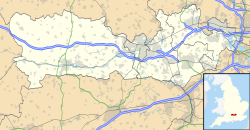History
The building, which was designed by the county surveyor, John Clacy, in the Baroque revival style and built at a cost of £21,644, was completed in 1861. [1] [2] It became the main venue for the assizes from 1867 when Abingdon County Hall ceded that role to Reading. [3] The design involved a symmetrical main frontage with seven bays facing onto The Forbury with the end bays projected forward; the central section of five bays featured a three-bay portico with Doric order columns; there were round headed sash windows flanked by Ionic order columns on the first floor. [1] The complex included the county police station which was built behind the courthouse. [4]
Following the implementation of the Local Government Act 1888, which established county councils in every county, it also became the meeting place for Berkshire County Council. [5] The administrative staff and committee rooms of the county council were accommodated in the Shire Hall next door. [6] Following the implementation of the Courts Act 1971, the former assizes court was re-designated Reading Crown Court. [7] In 1981 the county council moved to a new Shire Hall at Shinfield Park and subsequently it was used solely by the Crown Court. [6]
Important cases heard by Reading Crown Court included the trial and conviction of Leslie Bailey for the murder of Mark Tildesley in December 1992 [8] and the trial and conviction of Llewellyn Adams, Indrit Krasniqi, Michael Johnson, Jamaile Morally, Joshua Morally and Adrian Thomas for the murder of Mary-Ann Leneghan in March 2012. [9] It was also the venue for the Munir Hussain case, in which a businessman, Munir Hussain, was tried and convicted of assaulting a burglar, Walid Salem, in December 2009. [10]
The initial stages of the trial of Jed Foster for the killing of Andrew Harper were also heard at Reading Crown Court in August 2019, [11] but on 19 September the Crown Prosecution Service said that they had discontinued the case against him. [12] [13] [14]
This page is based on this
Wikipedia article Text is available under the
CC BY-SA 4.0 license; additional terms may apply.
Images, videos and audio are available under their respective licenses.

